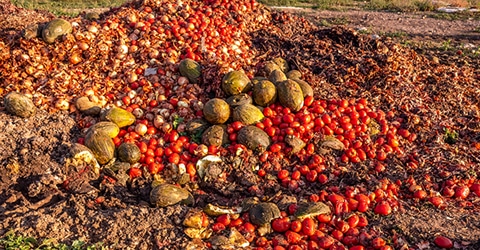Food waste isn’t a new problem, but recent events have highlighted its severity and the role it plays in the effort to create sustainable food systems. As impacts from the COVID-19 pandemic send ripples through the global supply chain, producers, retailers, and consumers are becoming more aware of the need to address wasteful practices.
What’s the real impact of food waste?
Food waste has wide-reaching effects from one end of the supply chain to the other:
- Farmers lose income on foods they can’t sell
- Fuel is wasted transporting food that spoils as it travels
- Retailers experience significant losses on unsold items[1]
Waste early on in the supply chain—during production, processing, or transportation—is known as food loss, whereas food waste includes the food retailers and consumers throw away.[2] Regardless of where it occurs, the impact is nothing short of devastating.
United States Food Waste by the Numbers
Between 30% and 40% of the entire US food supply is wasted every year. According to USDA Economic Research Service estimates, 31% of this loss occurs at the retailer or consumer level.[3] Another 40% occurs further up the supply chain, often resulting from:[4]
- Lack of field labor to support full harvests
- Poor storage and care during transportation
- Unnecessarily large orders
- An overemphasis on “attractive” food at the retail level
Overall, Americans waste an average of 80 billion pounds of food per year, amounting to approximately $161 billion in monetary losses.[5]
Global Food Waste Statistics
The picture isn’t much brighter around the world. About one-third of all food produced for people is lost or wasted every year. Some of the biggest contributors to the problem include:
- The United Kingdom, which wastes 32% of all food purchased, or about 6.7 million tons
- Europe, where annual food waste could feed 200 million people
- Africa, where 25% to 50% of food is lost or wasted after harvest
- Fruits and vegetables, of which 40% to 50% are lost or wasted
Average annual loss and waste totals amount to 1.3 billion tons (2.6 trillion pounds) of consumable food. Total monetary losses equate to around $680 billion in industrialized countries and $310 billion in developing nations.[6]
What can be done to reduce food waste?
Addressing major causes of food loss and waste will require significant supply chain reforms and changes in consumer behaviors. Many initiatives are being developed and launched in the United States and around the world to support the following key focus areas.
Increase awareness of…
- Where fresh, local produce can be purchased
- How to prepare all edible parts of plants
- Where excess food can be donated or composted
- Municipal infrastructure required to handle food waste responsibly
Provide education on…
- Proper food storage and preservation
- Meal planning and shopping
- Proper interpretation of “best by/use by” dates[7]
- How to use food that is about to go bad
- Better retail-level stocking, storage, and culling procedures
- Producer-level options for using unsold crops or products
- Local, state, and federal food waste-reduction initiatives
Shorten the food supply chain by…
- Promoting local, regenerative, and sustainable agriculture
- Investing in urban farming and vertical farming opportunities
- Creating food production opportunities in underserved areas (“food deserts”)
- Encouraging partnerships between local farms and businesses
Bring food to the hungry with…
- Donation programs that connect retailers with food pantries, homeless shelters, and city missions
- “Food rescue” initiatives that bring excess food from retailers and restaurants to people in need[8]
- Options for consumers to safely donate unused food items
Create new products using…
- “Ugly” or misshapen produce
- Spent brewery grains
- Leftover fermentation liquid
- Fruit and vegetable pulp discarded after juicing
- Leaves from plants like broccoli and cauliflower
Leverage technology to…
- Track products along the entire supply chain
- Assess quality at the time of harvest and during transportation
- Detect freshness and quality without damaging produce[9]
- Reduce production of the most commonly wasted foods
- Monitor and record food waste trends in the restaurant and hospitality industries
- Reveal areas of greatest loss across industries
- Create edible, plant-based produce coatings that prolong shelf life
By implementing new procedures and programs and taking advantage of technological advances, it should be possible to achieve the USDA’s proposed goal of a 50% reduction in nationwide food waste by 2030. Real change requires a combined effort between producers, distributors, retailers, and consumers to improve the supply chain and create an environment that supports a continued trend toward a society where food waste is a thing of the past.
References
- “Technical Platform on the Measurement and Reduction of Food Loss and Waste.” Food and Agriculture Organization of the United Nations. http://www.fao.org/platform-food-loss-waste/en/.
- “What Is Food Loss and Food Waste?” FCRNfoodsource. https://www.foodsource.org.uk/building-blocks/building-block-what-food-loss-and-food-waste#FLWBB2.
- “Food Waste FAQs.” USDA. https://www.usda.gov/foodwaste/faqs.
- Leonard, Matt. “Report: Supply Chains Cause 40% of Food Waste in North America.” Supply Chain Dive. July 02, 2019.
https://www.supplychaindive.com/news/developed-countries-food-waste-consumer-level-supply-chain/558023/.
- “Food Waste in America in 2020: Statistics + Facts.” Recycle Track Systems. https://www.rts.com/resources/guides/food-waste-america/.
- “Worldwide Food Waste.” Think.Eat.Save. https://www.unenvironment.org/thinkeatsave/get-informed/worldwide-food-waste.
- “The Nutrition Source. Food Waste: The Big Picture.” Harvard. September 04, 2019.
https://www.hsph.harvard.edu/nutritionsource/sustainability/food-waste/.
- “How We Fight Food Waste in the US.” Feeding America. https://www.feedingamerica.org/our-work/our-approach/reduce-food-waste.
- Cosgrove, Emma. “4 Technologies Tackling Food Waste in the Supply Chain.” Supply Chain Dive. September 12, 2018. https://www.supplychaindive.com/news/4-technologies-food-waste-in-supply-chain/532155/.

